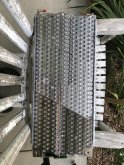Let me clarify. When the popping started, I went into the room where the system is housed. I heard a couple of loud popping sounds. I noticed the voltage on the charger controller was 28 volts. I shut off the battery cutoff switch and noticed the group of cells near the negative terminal were quite warm to the touch. At that time I checked the battery voltage and it was 5.3 volts. I was an electronics technician In the navy and this made no sense. I noticed the battery protector was flashing an error code of E1 (short). I assumed one of the cells was shorted. I went outside and disconnected the solar panels so the charge controller would shut down. Thats when I contacted you guys. I have since removed the entire battery from the room and its outside on a chair. I just checked the battery voltage now and its 21 volts and has been steady at 21 now for a while. Does that clear up any confusion? I dont believe the battery protector is the same thing as a battery management system (BMS). Any advice Now? Lol




